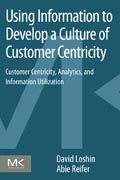
Using Information to Develop a Culture of Customer Centricity: Customer Centricity, Analytics, and Information Utilization
Loshin, David
Reifer, Abie
Using Information to Develop a Culture of Customer Centricity sets the stage for understanding the holistic marriage of information, socialization, and process change necessary for transitioning an organization to customer centricity. The book begins with an overview list of 8-10 precepts associated with a business-focused view of the knowledge necessary for developing customer-oriented business processes that lead to excellent customer experiences resulting in increased revenues. Each chapter delves into each precept in more detail. INDICE: Introduction: Describes the precepts at a high level and introduce the intent of the book.Who is a Customer? Everyone!: This chapter dispenses with the nonsense associated with trying to coalesce de facto concepts under a single name and instead provide a re-boot definition as a paradigm shift in terms of business-process customer orientation.The Customer Network and Sphere of Influence: This chapter contemplates the interconnectedness of individuals, households, and other hierarchical groupings that influence decisions about doing business with your company.Making Customer Centricity Pervasive in the Company: Discusses why changes to the IT infrastructure for managing customer data are insufficient to change the way the company works. The changes have to pervade the way people work with the data in the context of the business interaction, and the customer experience depends on these changes.You are the Brand: Every interaction and touch point between someone in the organization and anyone outside the organization contributes to the brand perception. The quality of each interaction is incorporated into the brand, and with more social network interactions exposing customer opinion, this will only increase. Listen to the Voice of the Customer: Considers how every customer touch point is an opportunity for engagement, and that the combination of information and analytics will help in addressing customer issues in an optimal way.Engage, Engage, Engage: The preponderance of channels for communication not only complicates tracking customer centricity, it confuses the customer base and makes it difficult to hear what they are saying. This chapter discusses the need to unify the methods by which customers communicate with the organization.Increased Revenues: These three chapters talk about optimizing business processes for creating value. This chapter talks about increased revenues.Decreased Costs: This one looks at decreasing costs.Protection of Brand: Discusses exposure to the brand and how customer engagement and improved experience can work in the company's favor.Analysis, Information, Process: This chapter ties it all together to suggest required changes to the existing way of doing things combines analysis with good information and process change. This is a summary but these topics are then covered in the next 3 books.
- ISBN: 978-0-12-410543-0
- Editorial: Morgan Kaufmann
- Encuadernacion: Rústica
- Páginas: 120
- Fecha Publicación: 11/01/2014
- Nº Volúmenes: 1
- Idioma: Inglés
